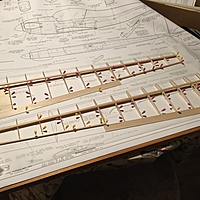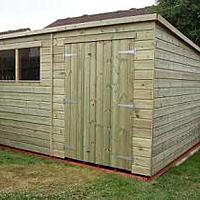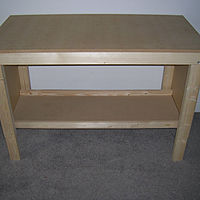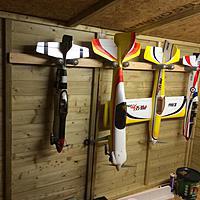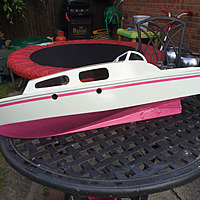Tech & Toys
-
West Wings Fournier RF4
While assembling the wings of my Fournier this evening it dawned on me that I hadn’t taken a single picture of the construction, so I snapped this to right that wrong! The fuselage is all but finished, just the tail feathers and servos to go in and then a bit of carving. I’ll try and take a few pics of that when I return to it after the wings.
I’ve also created a page for it here.
-
Engine list
I’ve recently completed a move to electric for my entire fleet so I thought it was appropriate to tidy up the IC engine pages because they won’t be seeing much of an update in the future. You can see the full list, with links to details about each engine here.
-
May Fly at Old Warden 2015
The lad and I popped along to the ModelAir May Fly at Old Warden this past weekend and had a great time. We picked up a couple of new models, a bit of sun burn and the photos you can see below.
-
New Shed
I’m a bit behind in updating the blog, but I thought it was about time to have a bit of a spree. Last spring I took the sledge hammer to the old shed which we inherited when we bought this house.
There is a very useful (maybe 12’ wide) path down the side of the house, between us and the neighbours where the previous owner had a couple of sheds. One of these looked very recent and in good condition, the other looked, well somewhat worse for wear. I had hoped it would last a season or two, but after a couple of weeks of rain everything inside was either sodden or mouldy, so a plan was hatched to replace it come spring.
As luck would have it just before the new shed was due to arrive I had a guy come to replace the rear fence, he was happy to remove all the bits of the shed with the old fence, which left me a nice clear space.
I bought a 10x5 Pent shed which is the biggest which would fit, managing to find one with doors in the long side, which meant I could use all the space available to me. A bit of wiring and a new bench later and it was starting to look like a proper shed. This online guide suggested how to make a handy model rack, so I followed their guidance and a good chunk of the fleet are now happily hanging up. I was going to build a bench, but the one in the picture on the right was a kit on ebay for 30 quid, which I thought was reasonable, so that made a welcome addition.
-
Couple of new Lego sets
[]({{ “/uploads/2015/03/42028_Webfiles_SECIMG2.jpg” | prepend: site.baseurl }})Over the few months a couple of new Lego sets have come into the house. First the latest Lego Ideas set; the Birds, these are amazing creations, looking more like ornaments than Lego. We’ve built only two so far, only the Robin remains to be built.
Next up is the Lego Technic Bulldozer, I’ve always had a soft spot for the Technic building range and this was a nice edition. It is proving to be robust enough for the kids to play with constantly without bits falling off, so we all win 🙂
-
Using a Raspberry Pi to control Maplin power sockets
For a while now I’ve been intrigued by the idea of home automation, but despite a large amount of research I’ve yet to take the plunge and buy anything. The one thing I do have is a bunch of these Maplin remote control sockets. These are simple things which just plug into any wall socket, then have a socket which you can plug any device into, a simple RF remote offers 8 buttons, on and off for each of the four sockets. The remote lets you choose from one of four channels meaning you can have four sets of four remotes all working within range of one another. I bought these originally because we had a few power sockets in awkward to reach places - who wants to move the sofa every time you want to turn a light on? - but never considered the possibility of using a computer to control them.
That was however, until I spotted a intriguing sounding tweet from Chris Swan directed at Andy Stanford-Clark:
** TWEET DELETED ** :(
Oh really Mr. Swan, now this does sound very interesting. I asked for some details and Chris pointed me at this blog post which explains pretty much everything I needed to know. The post linked to this library from Duncan McGregor which did the hard work and linked to the source of the transmitter I would need. Sorted then, this sounded simple enough!
I bought one of the transmitters and a ribbon cable with a plug that fitted the GPIO connector of the Pi. I planned to snip all but three cables from the ribbon, shorten the remaining ones and solder these to the 3 pins on the TX, the hope was with a very short wire from the GPIO plug to the TX I’d be able to hide it inside my existing case. The pin out of the GPIO and the connections you need to make are listed on Duncan GitHub repo in the Readme. But in short it goes like this:
Tx Pin Raspberry Pi Header Pin Pin 1 GND Pin 6 0V (Ground) Pin 2 Data in Pin 11 GPIO 0 Pin 3 Vcc Pin 2 5.0 VDC Power Pin 4 ANT 173mm antenna wire (not on the Pi!) Once I’d soldered the connections, I plugged the ribbon cable onto the GPIO and booted the Pi. One quick clone of Duncans repo later and I ran the following:
sudo ./strogonanoff_sender.py --channel 1 --button 2 --gpio 0 onAnd hey presto my fish tank light turned on. minor celebration 🙂
I wanted to try and avoid sudo access, but reading a few, things, decided that sudo was probably safest! So be it.
I’m pretty terrible at remembering that the fish tank lights are channel 1, button 2 so I wrote a short python script which accepts room names and a simple on or off:
It essentially just uses a Python dictionary to store the room to channel and button mapping:
switches = { 'bookshelf': { 'channel' : 4, 'button' : 1 }, 'tank': { 'channel' : 4, 'button' : 2 }, 'sofa': { 'channel' : 4, 'button' : 3 }, 'outside': { 'channel' : 4, 'button' : 4 }, 'spareroom': { 'channel' : 3, 'button' : 1 }, 'all' : True }I’ve put this script ‘switch.py’ into a repo in my Github account here. You run it like this:
./switch.py -s tank -a onThe success of all this lead me to consider actually building a remote control for these things that I could use on my phone, partly because it sounded like a neat thing to do and partly because finding the remote when the kids have been using it is non-trivial. The added, actually useful feature would be to turn lights off remotely when I go out and forget to turn them off.
So I pondered for a bit and sketched out a plan for a simple HTML UI running on a web server, somehow talking to the Pi to do the work. I didn’t want to expose the Pi to the internet because I already have a Linux box with a public IP and apache running on it and didn’t want two entry points into the house. I just needed a way of getting a command from a client browser, via the other linux box and onto the Pi. Then it dawned on me, I already use Mosquitto, the open source MQTT broker for moving temperature readings around, I could just use that. A bit more hacking lead me to write maplin-mqtt.py which is a variation of switch.py and simply subscribes to the MQTT broker and listens for messages containing commands.
I wrote it to expect JSON messages in the following format:
{ "channel": 3,"button": 2,"action": "off"}Testing this is as simple as using the command line MQTT publish client:
% mosquitto_pub -h trin -t foo/bar -m '{"action": "off", "switch": "spareroom"}'So now I just had to write a simple web UI which could publish messages of the correct format. I’ll write about that at another time because I hit upon something which changed my plans slightly 🙂
-
Sea Rover aka Nualas Boat
I’ve put a gallery of pics of the rebuild up on the Sea Rover page in preparation for writing up the work.
-
Updates
I’ve hauled the S-Pou out of the loft and intend to start flying it again at our clubs indoor evenings. Hence I’ve moved its page out of Historic and into the RC Aircraft section and updated it accordingly.
I’ve also added the following new kits to the Lego page:
- 21108 - Ghostbusters Ecto-1
- 21109 - Exo Suit (Broken link
http://shop.lego.com/en-GB/Exo-Suit-21109) - 21301 - Birds
- 10242 - MINI Cooper
Hopefully I’ll update the blog more often in 2015, I’ve written quite a lot of code recently, and done some cool things with my Raspberry Pi. I must also try and write up the renovation of the Sea Rover!
